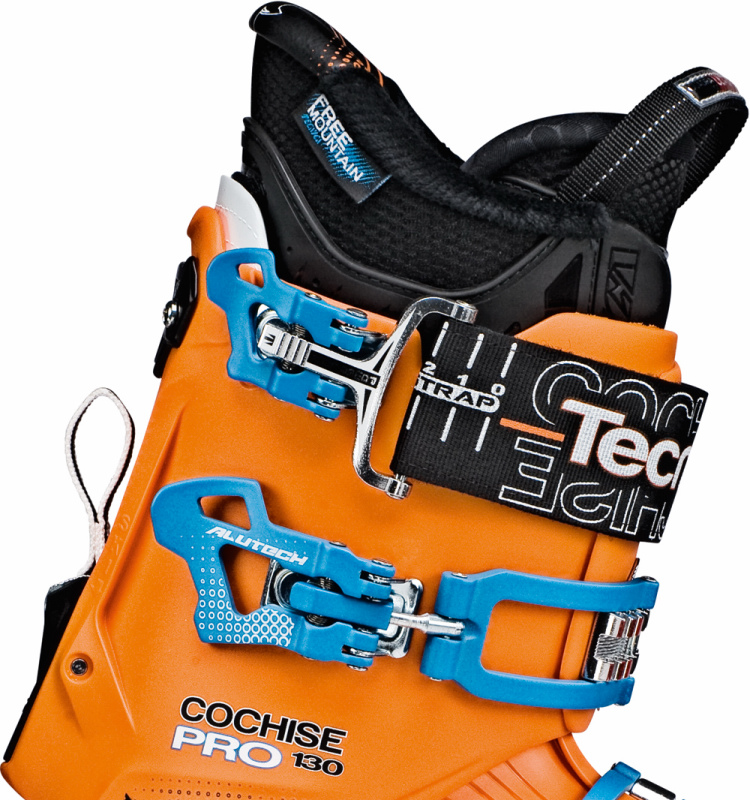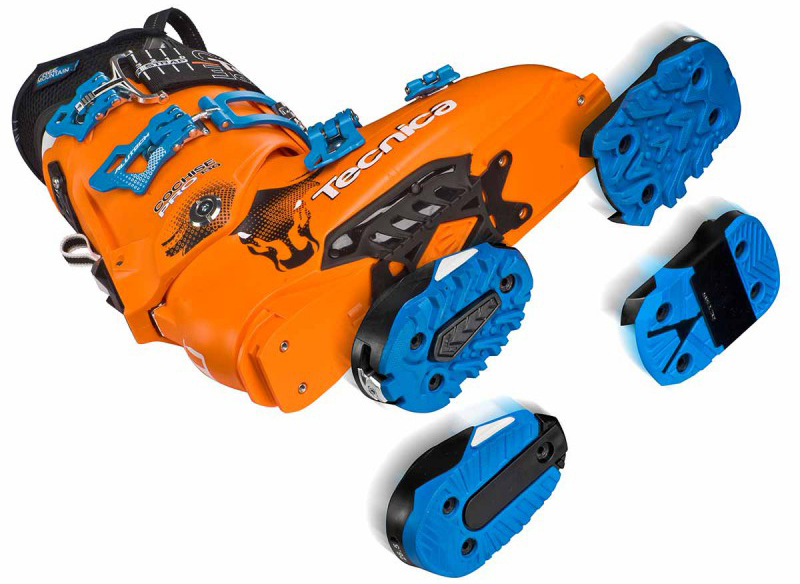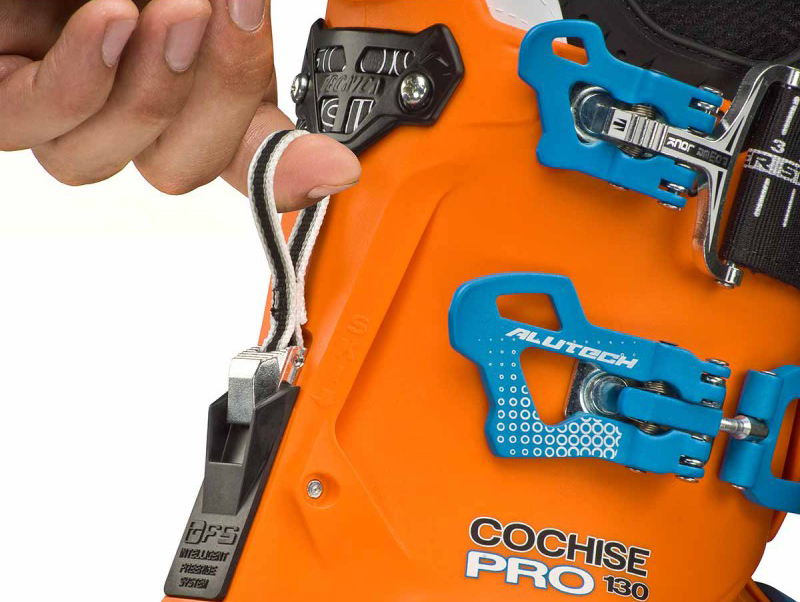Buckles
The Cochise 130 Pro’s buckles appear relatively unchanged from previous versions of the boot. They are low-profile metal buckles, and I’ve had no issues with them during the time I’ve used the boot.
The real story about the buckles used in the Cochise line is the top-most, Power Lock Buckle, also carried over from previous iterations of the boots. It’s the best top buckle system I’ve used, and I’d be happy to have this buckle on every ski boot I own. (I’m scheming up ways to get a set of these on my Vulcans.)

The Cochise 130 Pro’s Power Lock Buckle provides almost as much support as the top buckle + booster strap combo I have on my other boots, but it’s significantly lighter. More importantly, it allows you to loosen, open, and close the boot’s top buckle very easily.
Ordinarily, whether I’m unbuckling for a hike, getting back in the helicopter, or jumping on the chairlift, I find myself fumbling with the power straps of other boots, which are made harder to reach by baggy ski pants and their internal gaiters. With the Cochise’s Power Lock Buckle, I can easily flick open the top buckle, making the boot’s upper instantly loose. It is similarly easy to tighten things back down at the top of the run, as I never have to worry about adjusting the tension on the top power strap; it’s already set, thanks to the Power Lock Buckle’s design.
Sole Blocks
I have only had the chance to use the DIN sole blocks that came with the Cochise 130 Pro. (Tech soles are sold separately.) They worked perfectly with the Marker Jester bindings we use on our test skis.
The soles also have a soft rubber grip on them, which is great if you’re scrambling on rocks, scree, wood, and ice as we did regularly during our trip to New Zealand. After a couple weeks of abuse, the rubber soles of the Cochise 130 Pros have held up as well as any others I’ve used.

The Cochise’s sole blocks are attached to the lower shell with allen bolts that screw into metal t-nuts seated in the lower shell. This is different from the wood screws that interface directly with the lower shell plastic of the Quest Max BC 120. As I mentioned in my review of the BC 120, one of these screws stripped out the plastic in the shell. I have had no such issues at all with the 3 pairs of Tecnicas I’ve used (the 11/12 Bodacious, 12/13 Cochise 130 Pro, 14/15 Cochise 130 Pro), so Tecnica’s system seems to be more durable and dependable on the whole.
Like the older versions of the boot, the Cochise 130 Pro features a rubber piece that sits between it’s sole blocks on the bottom of the boot. While this may add some weight (it’s absent on the more touring-oriented Cochise Light Pro) I find it to be a great feature. I spend a fair amount of time riding snowmachines and climbing in and out of helicopters and snowcats, often balancing on the middle of my boots’ soles, so it’s great to have a little bit of grippy rubber in this area.
I was also happy to learn that canted sole blocks are available for the Cochise 130 Pro and Tecnica Mach 1. Given my canting issues, I’m looking forward to trying a pair of canted sole blocks with the boots as soon as possible.
Weight
Tecnica claims that the new shell Cochise 130 Pro’s shell is 10% lighter than last season’s version, thanks to a new type of plastic. Given that the Cochise is essentially an alpine boot with a walk mode, I think that ~2,000 grams per boot is pretty good, even if you’re planning to use the boot for touring quite often.
The stock liners are a little heavy compared to other alpine liners (those of the Bodacious and Salomon X Max 130), but the shell is still relatively light.
And if you use an Intuition liner (which in my case weighs about 300 grams with an insole) the boot’s total weight comes in around 1,920 grams. That’s very close to the similar, touring-oriented Quest Max BC 120 that weighs 1,980 grams with its stock liner.
Walk Mode
The Canterbury club fields have an abundance of hike-to terrain, and I spent a lot of time hiking on snow, ice, and rocks in the Cochise 130 Pro in walk mode.

Tecnica states that the new boots have 8 degrees more articulation than older versions. While walking down stairs or though scree fields, I noticed that the Cochise doesn’t allow for quite as much articulation as my Vulcans. But for everything else, it was quite adequate. On the whole, I never felt restrained by the range of motion the boots’ allowed, even while using the my Intuition wrap liner.
I should also note that when they are locked into ski mode, the boots feel solid, with no discernible play from the walk mode latch. In my old Cochise 130 Pros, I noticed a small amount of play in the walk mode mechanism right out of the box. After a month of skiing and hiking, this became quite noticeable while in ski mode, with a 5-10mm of play when measured at the top of the cuff. I’m happy to say I haven’t experienced that at all with this new version.

Great review. Can you describe the forward flex a bit. Does the boot have a progressive forward flex or is it more like the Vulcan?
Hey Max, Thanks for the comments. The flex is much closer to a more traditional alpine boot like the Salomon X-Max 130 I was in last year than it is to the Vulcan. It is more progressive than the Vulcan with a deeper range. As an aside, in my experience the Vulcan does ramp up relatively quickly but I have found that it flexes deeper than most reviews I have read would suggest.
So, in your experience, do you think that companies like Tecnica have solved the problem of not being a “real” 120 or 130 flex when having a walk mode? Obviously, other boots in that flex class that don’t have walk modes have bolts through the rear. Is there something in the ski lock part of the ski/walk mechanism or some other design feature that accomplishes this? We are probably a similar size, and I like to lean forward. Sometimes I need a reminder, and I find a not too soft boot that is really leaned forward helps recover from backseat driving.
Thanks for reading and for your comments. The caveat to what I’m going to say and to this review is that I had not skied any other boot since early June when I tested the Cochise. I may revise my opinion when I can ski them back to back at the hill in direct comparison to other boots. The Cochise is enough boot for anything I do, including skiing fast with a heavy pack. The flex is progressive like other alpine boots. The X-Max 130 (14/15 version if it matters) is not among the stiffest of the “130” boots on the market, but I think the Cochise flex is just as progressive and smooth as the X-max. So yes, in my opinion, the walk mode on this boot (and the Salomon walk-mode boots I’ve used) effectively bolts the shells together so that the boot flexes very similarly to a comparable alpine boot. All of that said, 2 years ago I regularly skied both the Bodacious and the Cochise Pro 130 which shared the same lower shell and had the same purported flex of 130. While both were progressive in flex, the Bodacious did feel stiffer overall in forward flex.
Paul,
Thanks for your work and another great review. This is very helpful stuff. I am looking in this category of boot and I love the features on the Cochise, but I may need a wider last. Do you have any comments on its comparison to the Rossignol Alltrack 130 Pro?
Hy Ryan, Thank you for your comment. I have no experience with the Alltrack series. I would definitely check with your local boot-fitter before you rule out the Cochise or any other boot based solely on the stated last width. Depending on your foot, it may be a great boot for you with a some strategic punches.
Cochise 120 has a 100mm last. Might be what you’re looking for if you can tolerate a slightly softer boot.
thanks for that review. maybe i am not understanding the key sentences right, because of not being a native english speaker.
maybe you can help me out. i understood that the new cochise is lower volume overall.
new cochise 130 vs old cochise 130:
internal shell longer vs shorter ?
instep is lower
calf “volume” the same?
the old cochise is the best boot i ever had, but it´s bit too big overall and too short in length for me.
so i have two bontex to adjust volume but can barely fit my own liner in it (lengthwise).
if the new boot would adress that i am on the border, getting a new one.
Thanks for your comment. Your best bet is to go see your local bootfitter and have him or her take a look at your feet and this boot. I’ll give you the best info I can but highly recommend you check in at your local shop.
It does seem a little lower volume overall but the differences are more nuanced than that. The heal pocket seems al little more shaped and provides subtly better hold for my foot. The instep is a little lower in my experience. Lengthwise, I do not think there is a difference. The BSL is unchanged and. lengthwise, the shell fit is the same for me. The forefoot seems to have little more width at the 5th metatarsal but it was still not enough room for me so I had an additional punch there. Check with your bootfitter and let us know how it goes for you.
Great review! Have you tested the K2 Pinnacle 130 and if so how do they compare? Will you do a review of that boot? I have tried the cochise in stores and it fit my foot really well, but I am a bit concerned about the stock liner. In your experience, is there a big difference in comfort and warmth between intuition liners and the cochise stock liners? The days you skied in the stock liners, did you have any other concerns than the lower volume in the instep?
Ditto on the 2015 K2 Pinnacle 130. Curious how the LV version stacks up against the Cochise.
Any idea how the fit of the new 130s compares to the new 120s? Are the 130s narrower throughout or just in the toe? Thanks
I haven’t skied any of the 120 versions of the boot. This would be a great question for your bootfitter. Best case would be to size up both boots and see if you can tell the difference. Best of luck with your bootfitting!
I was wondering what kind of boot you would recommend to someone who is looking to getting into sidecountry/backcountry skiing. I have Tyrolia Attack 16 bindings on my daily drivers and I was hoping to be able to have a boot that would still be compatible with those bindings as well as an AT binding. I consider my feet to be somewhat wide, so a wider boot would be nice. Any help would be appreciated! Thanks
I think the Cochise Pro would be a great choice for sidecountry with some pure skinning days mixed in. I was also impressed with the Salomon Quest Max BC120 and suspect the Salomon line-up is also worth a look. You might check out the BD Factor series as well. All of those will also allow you to use tech bindings if you choose. Try to get your foot in any of those boots and see what works best for you. Enjoy!
I’m curious if the Intuition Power Wraps changed the flex of the boots. Did they stiffen them up? I’d like to use my old PowerWraps but don’t need a stiffer boot. Thanks!
The Powerwrap Pro liner did stiffen them up although it was not as dramatic of a difference as I’ve noticed when I added a wrap liner to some of the touring boots I’ve used. When I was in New Zealand on a relatively warm day I skied back to back runs with the stock liner and then the Powerwrap. While the difference in comfort for me was marked, the difference in flex was present but more subtle. I hope this helps. Best, Paul
Paul,
Any update to how you would compare the Cochise 130 to a standard Alpine boot (like the X Max 130) now that its later in the season and you have likely had more time in other boots? I am giving up on my Lange RS130’s Wide in 26.5. Have a size 27 foot with a high instep and regardless of the work done to them, my feet are ice cold and wet (work has just made them wetter and created more leak points). Boot fitter that put me in the Langes did me a disservice – although a great boot – not great for the type of foot I have. Have a choice between the Cochise 130 I can grab online or the X Max 130 here in a local store. Looking for something as responsive as possible for resort skiing (although I always do side country as well) but that wont leave my feet hurting for days.
Thanks!
Hey TJ, Sorry for the delay. Over the past few weeks I have been skiing the X-Max 130’s inbounds at Alyeska and the Cochise Pro’s for heli-guiding. It’s not a perfect comparison because the skis and snow conditions are different but I have Powerwrap liners in both boots. The X-Max does feel a tiny bit stiffer fore-aft but the Cochise is easily enough boot for me. I think the 4th buckle in combination with the Booster strap I added to the X-Max accounts for part of the increased stiffness. The most noticeable difference for me is that the fit around the ankle (and to a lesser degree, the heel pocket) is looser in the Cochise. When in bouncy, hard snow the X-max gives me better edge hold laterally and feels a bit more solid. I hope this helps.
Tecnica has made a great backcountry boot for a large volume foot into an inbounds boot(a precise liner) with little room for warmth for those who need room in the toebox.
I had a similar experience with sloppy heels in the older Cochise Pro 120’s. Had heel wedges put in by the local shop. This took up the room in the heel and put me a little more on my toes. Perfect. I have been on those boots for the last three years, free-skiing and patrolling. No other fitting required, but I am probably going to need new liners this year. Best boot ever.
I tried these a day ago on our annual winter sports fair, among 7-8 other high-flex low volume boots from every known manufacturer. And god, did they feel good, it was like 2 angels were holding my feet with their their blissful hands softer than the softest cashmere. Right out of the box!
I have a low volume feet and barely any instep, and skinny calves. Size 28.
But the thing Is, I ski 90% on paved slopes (SL, GS) so I’m not sure should I go for a freeride declared boot?
Hey, good review. I’m shopping for bindings and would like to know if Cochise boots with the dynafit sole blocks work with Rossignol FKS bindings, or would I have to swap them out with the din ones? (I tour on dynafits)
Might go for Jesters if that is the case.
As always…Stellar review. I cannot tell you how often I come to Blister to help me make informed decisions about my gear. This is a random question, but do you recall what size Intuition Powerwrap Pro liner you put in to the 27.5 boot? Thanks so much for all your help!
Thanks for your review. I use both the x max 130 and the Cochise 130. Do you use two different intuition power rap liners or share the liner between boots?
Do you get on with the liner in walk mode with the power wrap over the pro tour?
PS I bought the Cochise 130 after reading your reviews and already had the x max 130 but needed tech inserts for the shift binding. I prefer the x max for precision and hold